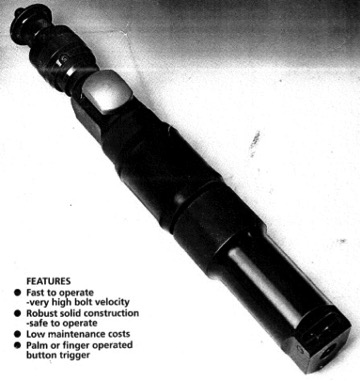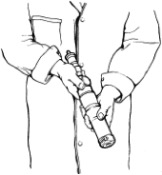Worker struck in abdomen with stun gun
In February 2022, a worker suffered serious injuries after being struck in the abdomen by a loaded captive bolt stun gun (also known as cattle gun, bolt gun, stun gun or stunner). Early investigations revealed the worker was part of a maintenance team and was cleaning the loaded captive bolt gun when it fired.
These findings are not yet confirmed, and investigations are continuing into the exact cause.
Safety issues
A captive bolt gun (bolt gun) is used on animals to be slaughtered. The animal is instantly rendered unconscious(without causing pain)ahead of slaughter. A bolt gun has a steel bolt that is powered by either compressed air or a blank cartridge. When it is fired, the bolt rapidly extends but is retained and then retracts. At close range, a bolt gun has the same effect on the animal as a firearm with a live bullet but may be considered safer because the extending bolt is retained when fired.
However, all bolt guns are potentially lethal. Injuries from bolt guns can be caused by the user inadvertently activating the gun into a part of the body. It is essential safety and operating procedures recommended by the manufacturer are followed and all users are properly trained in safe operation and maintenance.


Ways to manage health and safety
Taking steps to manage risks is a condition of doing business in Queensland. Effective risk management starts with a commitment to health and safety from those who manage the business. If an incident occurs, you'll need to show the regulator that you’ve used an effective risk management process. This responsibility is covered by your primary duty of care in the Work Health and Safety Act 2011 .
Use the hierarchy of controls to help decide how to eliminate and reduce risks in your place of work. The hierarchy of controls ranks types of control methods from the highest level of protection and reliability to the lowest. It’s a step-by-step approach to eliminating or reducing risks. You must work through the hierarchy of controls when managing risks, with the aim of eliminating the hazard, which is the most effective control.
Possible control measures to prevent similar incidents
All safety procedures recommended by the manufacturer need to be followed, and all workers who operate and/or maintain mechanical stunning equipment (such as bolt guns) must be properly trained. Equipment must be regularly checked. The following procedures should be followed:
- when handling bolt gun equipment, during and on completion of loading, the muzzle must at all times be pointed away from any part of the operator’s, or any other person’s, body
- refer to manufacturer’s instruction sheet for the correct loading procedure and correct cartridge. Avoid repeated use of too heavy a cartridge, or air shots, which can result in the bolt shearing and flying free of the bolt gun
- bolt guns should always be handled as if they are loaded
- once the bolt gun has been loaded, ensure the mechanism is in the ‘safe’ position until an animal is ready to be stunned
- never leave a loaded bolt gun unattended
- in the event of a misfire, do not open the bolt gun breech for 30 seconds. Sometimes slow primer ignition will cause a ‘hang fire’ and the cartridge will explode after a short pause
- at the end of the day’s kill, return the bolt gun to the person appointed to carry out the daily cleaning procedure
- make certain the bolt gun is unloaded before cleaning
- immediately report any faults in the operation of the bolt gun to the maintenance person and do not use the equipment until the problem has been rectified
- ensure the bolt gun, when not in use, is always stored securely.
(Source: Humane Slaughter Association – www.hsa.org.uk)
Before carrying out maintenance on any plant, including bolt guns, you need to ensure maintenance activities comply with requirements under relevant work health and safety legislation.
Effective control measures for maintenance activities are often made up of a combination of controls. Some common risk control measures can include but are not limited to the following examples.
- Develop a safe system of work for maintenance, repair or cleaning activities. This could include, but is not limited to:
- ensuring the plant is inspected, maintained and repaired according to the manufacturer’s recommendations and specifications
- bolt guns should be dismantled, cleaned and lubricated after use, even if they are fired only a few times a day, or even less frequently
- back-up equipment must also be regularly serviced, even if it has not been used.
- Providing information, training, instruction and supervision to workers who use the plant that includes developing safe work procedures in accordance with the manufacturer’s instructions.
- Developing an isolation procedure which should be followed by workers when they are required to perform maintenance, repair and cleaning of plant. Isolation procedures involve isolating potentially hazardous energy so the plant does not move accidentally.
It is also good practice to keep records of plant in your workplace. Records on items of plant that may be kept include:
- information on alterations
- information on maintenance and major repairs
- manufacturer’s specifications and user manuals
- results of tests on the plant including safety devices
- determining what special skills are required for people who operate the plant or carry out inspection and maintenance, including preventative maintenance.
Adopting and implementing higher order controls, before considering administrative or PPE controls, will significantly reduce the likelihood of a similar incident occurring. The control measures you put in place should be reviewed regularly to make sure they work as planned.
More information
- Managing the work environment and facilities Code of Practice 2021 (PDF, 0.57 MB)
- Managing the risks of plant in the workplace Code of Practice 2021 (PDF, 1.57 MB)
- Captive Bolt stunning of livestock (HSA-UK)
Support for people affected by a serious workplace incident
For advice and support: